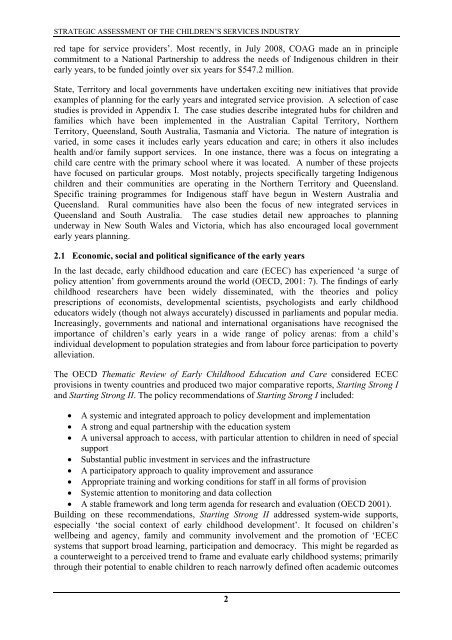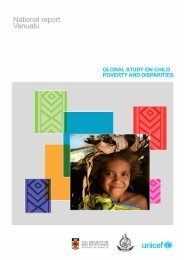A Strategic Assessment of the Children's Services Industry
A Strategic Assessment of the Children's Services Industry
A Strategic Assessment of the Children's Services Industry
- No tags were found...
Create successful ePaper yourself
Turn your PDF publications into a flip-book with our unique Google optimized e-Paper software.
STRATEGIC ASSESSMENT OF THE CHILDREN’S SERVICES INDUSTRYred tape for service providers’. Most recently, in July 2008, COAG made an in principlecommitment to a National Partnership to address <strong>the</strong> needs <strong>of</strong> Indigenous children in <strong>the</strong>irearly years, to be funded jointly over six years for $547.2 million.State, Territory and local governments have undertaken exciting new initiatives that provideexamples <strong>of</strong> planning for <strong>the</strong> early years and integrated service provision. A selection <strong>of</strong> casestudies is provided in Appendix I. The case studies describe integrated hubs for children andfamilies which have been implemented in <strong>the</strong> Australian Capital Territory, Nor<strong>the</strong>rnTerritory, Queensland, South Australia, Tasmania and Victoria. The nature <strong>of</strong> integration isvaried, in some cases it includes early years education and care; in o<strong>the</strong>rs it also includeshealth and/or family support services. In one instance, <strong>the</strong>re was a focus on integrating achild care centre with <strong>the</strong> primary school where it was located. A number <strong>of</strong> <strong>the</strong>se projectshave focused on particular groups. Most notably, projects specifically targeting Indigenouschildren and <strong>the</strong>ir communities are operating in <strong>the</strong> Nor<strong>the</strong>rn Territory and Queensland.Specific training programmes for Indigenous staff have begun in Western Australia andQueensland. Rural communities have also been <strong>the</strong> focus <strong>of</strong> new integrated services inQueensland and South Australia. The case studies detail new approaches to planningunderway in New South Wales and Victoria, which has also encouraged local governmentearly years planning.2.1 Economic, social and political significance <strong>of</strong> <strong>the</strong> early yearsIn <strong>the</strong> last decade, early childhood education and care (ECEC) has experienced ‘a surge <strong>of</strong>policy attention’ from governments around <strong>the</strong> world (OECD, 2001: 7). The findings <strong>of</strong> earlychildhood researchers have been widely disseminated, with <strong>the</strong> <strong>the</strong>ories and policyprescriptions <strong>of</strong> economists, developmental scientists, psychologists and early childhoodeducators widely (though not always accurately) discussed in parliaments and popular media.Increasingly, governments and national and international organisations have recognised <strong>the</strong>importance <strong>of</strong> children’s early years in a wide range <strong>of</strong> policy arenas: from a child’sindividual development to population strategies and from labour force participation to povertyalleviation.The OECD Thematic Review <strong>of</strong> Early Childhood Education and Care considered ECECprovisions in twenty countries and produced two major comparative reports, Starting Strong Iand Starting Strong II. The policy recommendations <strong>of</strong> Starting Strong I included:• A systemic and integrated approach to policy development and implementation• A strong and equal partnership with <strong>the</strong> education system• A universal approach to access, with particular attention to children in need <strong>of</strong> specialsupport• Substantial public investment in services and <strong>the</strong> infrastructure• A participatory approach to quality improvement and assurance• Appropriate training and working conditions for staff in all forms <strong>of</strong> provision• Systemic attention to monitoring and data collection• A stable framework and long term agenda for research and evaluation (OECD 2001).Building on <strong>the</strong>se recommendations, Starting Strong II addressed system-wide supports,especially ‘<strong>the</strong> social context <strong>of</strong> early childhood development’. It focused on children’swellbeing and agency, family and community involvement and <strong>the</strong> promotion <strong>of</strong> ‘ECECsystems that support broad learning, participation and democracy. This might be regarded asa counterweight to a perceived trend to frame and evaluate early childhood systems; primarilythrough <strong>the</strong>ir potential to enable children to reach narrowly defined <strong>of</strong>ten academic outcomes2
















